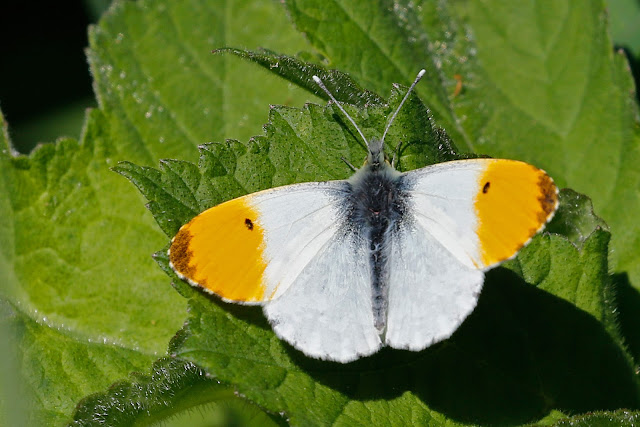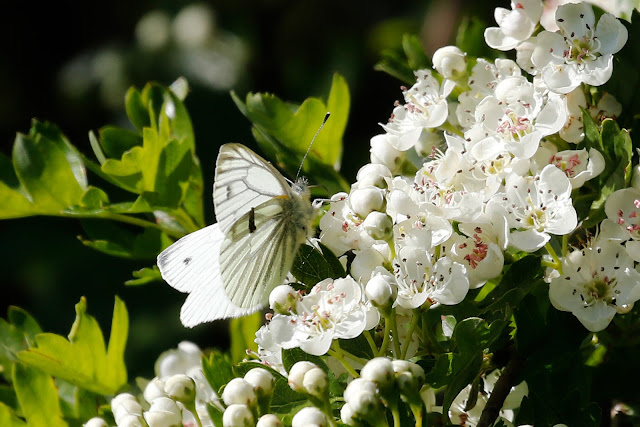A little further along another set of soulful notes caught the ear, but this time a much shorter song, and no repeated notes. It was a male Redstart, and after searching the trees we found it at the top of the tallest Oak.
Hopefully we would get a better view of one, this one being high in the tree was difficult to photograph, the angle just giving you the majority of its underside.
As we approached a group of Scots Pine on our right several birds flew from a puddle and into the pine trees. Once they settled in the trees it was easy to see them as they moved around the edge attacking the small cones. There were two female Crossbills, and a male. The male was busy taking apart a pine cone.
First twisting the bill into the cone.
Then pulling the cone off, and eventually dropping it to the ground.
It then moved to the other side of the tree and started on another cone.
Eventually the little group moved on calling as they flew away across the tops of the pines.
Siskin could also be heard calling from the pines, and every so often one would fly across in front of us. A little further on and another Redstart was singing from the top of a pine, this time not so high and a little closer. The early morning sun catching the beautiful colours in the male bird.
Chaffinches were singing around us, and every so often when they start to sing they can sound like a Wood Warbler, but when we actually heard a Wood Warbler there was no mistaking the beautiful song. This bird was singing just before the 100 marker on the path, and we walked into the undergrowth to find it, and it was as usual singing in one of the darkest areas making photographs difficult.
When it did come into the light there was then the challenge of over exposing to get some detail when looking up into the sky.
Finally it behaved and I was able to get an acceptable shot. I love the symmetry of the yellow fringes on the primaries as they drop down below the tail as it sings.
Watching the Wood Warbler we became very aware of the midges that were about under the trees, so after awhile we decided to leave and carry on along the path.
As we reached the stream, where it meanders around a series of bends, and just before the bridge a Firecrest sang, and showed very well in the conifers by the bank of the stream
I don't know how many pictures I have of Firecrests, they are stunning little birds.
We walked around to a clearing where last year we had seen Spotted Flycatcher, unfortunately there wasn't any this year and we had to make do with yet another singing Wren.
As we walked around this area we could hear a Redstart singing above us, but try as we might there was no sign of it anywhere, we just had the song to tell us it was there.
We made our way back to the car park, and picked up the 'scopes to head up onto the down. Taking the lower path we passed a singing Blackcap, and another Redstart. We walked around the down, and then down into the valley on the other side where there were two pairs of Stonechats calling, this male calling away from a Silver Birch.
Both pairs were seen carrying food.
We walked back up the main path, then crossed to the boggy area, a good site for Sundew plants. We found several, but they seemed to be a lot smaller than those we had seen here this time last year, probably as an account of the recent cold weather.
This is a Round-leaved Sundew and is usually found sitting
among the soggy Sphagnum mosses at the shores of bog pools, on wet heaths and
peaty moors. In this case we were in the
middle of a moss bog, the water appearing above the boots if you stood still
long enough.
It is a tiny, slender plant, it’s reddish leaves and diet that make it stand out from the crowd. On each leaf, hair-like tendrils tipped with glistening droplets attract passing insects. But this 'dew' is very sticky and when the tendrils detect the presence of prey, it curls them inwards, trapping the insect. Eventually, the whole leaf wraps around the prey; the enclosed insect is digested and the nutrients absorbed by the plant. The acidic boggy habitats the Round-leaved Sundew lives in don't provide enough nutrients, so it has evolved this carnivorous way of life to supplement its diet.
Leaving the bog, we climbed up the side of the hill, and stopped to watch displaying Tree Pipits, one landing close to us and made its way through the grass.
From here we walked up to the viewpoint where we settled down to watch for raptors. The conditions were ideal, and the visibility perfect. So looking out across Bolderwood in the distance, expectations as always were high.
We were treated to some distant but quite good scope views of at least four Goshawks, as the flew around the shape and white vent always clearly visible. Every so often one would perch up on a dead conifer, again very distant but a record that they are there.
One bird of interest aside from the calling and bubbling Cuckoos was a Hawfinch that flew past, unfortunately missed by Ian.
We were hoping for Honey Buzzard, but as midday approached we had to make a decision, do we stay, or with the skies clear and in a sheltered spot the sun being warm, do we go and look for butterflies.
Walking back to the car park a Buzzard above us was being mobbed by two crows.
We decided on a trip to Bentley Wood in search of Pearl-bordered Fritillaries, and after lunch and a pleasant journey through the northern part of the forest we arrived to find almost all of the butterfly watchers were here too.
Walking in to the eastern clearing there were people everywhere. However it didn't take long to see our first fritallary, and not long after that our second, in fact they just kept appearing around us.
Very strong flyers they were very mobile and would only settle for a short while.
It gets its name from the series of "pearls" that
run along the outside edge of the underside of the hindwing.
The males were flying swiftly, low across the site and were
extremely difficult to follow, the colouring of the wings providing excellent
camouflage against the dead bracken that they seemed to stay around.
Finally one did settle with wings flat.
The main reason for the interest, and so many people here was one Pearl Bordered that was a possible aberration from the normal form. We were not aware to start with, but were lucky to find it and possible because it had been chased all over the site it was tired and settled nicely for us.
A singing Garden Warbler took our attention away from the butterflies, and we managed to find it singing in a willow tree.
I must admit it wasn't much fun with so many people so we decided to head back and to take the opportunity to drop into Magdalen Hill. Bit before we left there was still time to get a good view of my first Speckled Wood of the year.
The last time I had been at Magdalen Hill it was covered in blue and red flowers, today it was covered in Yellow, thousands of Cowslips spread out in front of us.
We made our way around to the chalk pit, the sun was still very warm, and the south facing slopes were sheltered from the cool northerly wind that was keeping the air temperature down.
Ian disturbed what he thought was a skipper, but turned out to be the first Small Blue butterflies of the year.
There were two and they looked immaculate, probably just having emerged.
They were also already quite feisty, the two not wanting to share the space with each other.
There is definitely something uplifting and special about seeing a blue butterfly.
Leaving the chalk pit we walked down the slope to the bottom of the hill. Apart fro many Orange Tips that passed us, it was quiet, and just as we were beginning to question where we should be, Ian disturbed two small butterflies. One turned about to be a Grizzled Skipper, a first for us both.
Ian focused on the skipper while I chased the other butterfly that turned out to be a rather special Brown Argus.
Lying down you could get close until suddenly they would just spring up into the air with amazing speed and acceleration.
We carried on and made our way to the top of the hill, where there are wonderful views away to the south. In the air Swifts and House Martins fed on the many insects that seemed to be all around us.
As we made our way back, a Brimstone finally paused on a Cowslip.
In the sheltered corner of the east side of the reserve we sat and watched Orange Tips.
While there a Holly Blue flew past us, and a Speckled Wood chased the Green-veined Whites that we were trying to photograph. Finally one settled long enough for us to get in close.
looking quite special on the May blossom.
It had been a very successful day, quality birds in the morning,and some wonderful butterflies in the afternoon, including a firs for me, the Grizzled Skipper, and for May a very respectable count of 13 species of butterfly. When I heard the forecast early in the week, I would never have though that possible.








































No comments:
Post a Comment